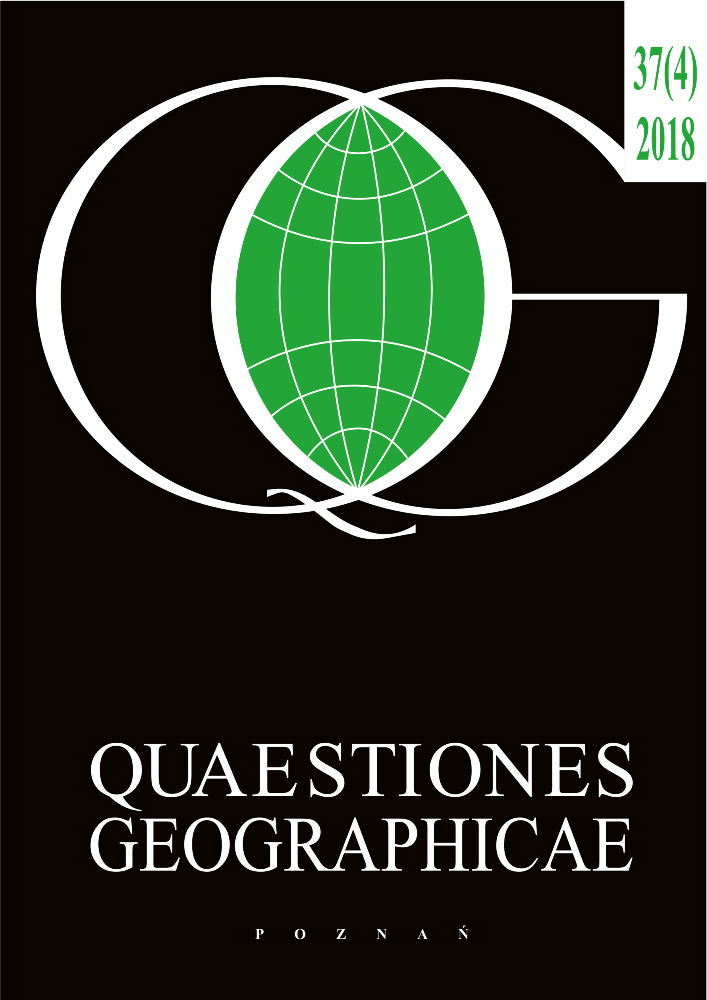Abstract
Kopczewska (2017) proposed a new empirical measure of spatial agglomeration (SPAG) of economic activity based on geolocations of firms. The aim of the paper is to introduce theoretical backgrounds of SPAG. The measure is a product of two random variables with beta and gamma distributions. The moments of the product are described and estimated for Poland with spatial centroids of LAU2 treated as geolocations of firms for empirical distribution as well as for the set of firms located in a regular region. Another approach to SPAG properties has its origin in a geometric probability concept. We present the research results on geometric probability, applied to SPAG, as distance probability distributions for a regular region.
Funding
Polish National Science Centre www.ncn.gov.pl as the research project in OPUS 6 call, contract No. UMO-2013/11/B/HS4/01098
References
Alagar V.S., 1976. The distribution of the distance between random points. Journal of Applied Probability 13(3): 558– 566.
Arbia G., 2001a. Modelling the geography of economic activities on a continuous space. Papers in Regional Science 80: 411–424.
Arbia G., 2001b. The role of spatial effects in the empirical analysis of regional concentration. Journal of Geographical Systems 3: 271–281.
Arbia G., Piras G., 2009. A new class of spatial concentration measures. Computational Statistics and Data Analysis 53: 4471–4481.
Arbia G., Espa G., Giuliani D., Mazzitelli A., 2010. Detecting the existence of space-time clustering of firms. Regional Science and Urban Economics 40(5): 311–323.
Arbia G., Espa G., Giuliani D., 2015. Analysis of spatial concentration and dispersion. In: Karlsson C., Anderson M., Norman T. (eds), Handbook of Research Methods and Applications in Economic Geography. Elgar: 135–157.
Baddeley A.D., 2000. The episodic buffer: A new component of working memory? Trends in Cognitive Sciences 4: 417–423.
Duranton G., Overman H.G., 2005. Testing for localization using micro- geographic data. The Review of Economic Studies 72(4): 1077–1106.
Duranton G., Overman H.G., 2008. Exploring the detailed location patterns of UK manufacturing industries using microgeographic data. Journal of Regional Science 48: 213–243.
Guillain R., Le Gallo J., 2010. Agglomeration and dispersion of economic activities in and around Paris: An exploratory spatial data analysis. Environment and Planning B, 37: 961–81.
Kendall M.G., Moran P.A.P., 1962. Geometric probability. Griffin Statistical Monographs. Griffin, London.
Kopczewska K., 2017. SPAG – index of spatial agglomeration. In: Kopczewska K., Churski P., Ochojski A., Polko A. (eds), Measuring regional specialisation. A new approach. Palgrave Macmillan, Cham, Switzerland: 189–216.
Marcon E., Puech F., 2003. Evaluating the geo-graphic concentration of industries using distance-based methods. Journal of Economic Geography 3(4): 409–428.
Marcon E., Puech F., 2010. Measures of the geographic concentration of industries: Improving distance-based methods. Journal of Economic Geography 10(5): 745–762.
Moran P.A.P., 1966. A note on recent research in geometrical probability. Journal of Applied Probability 3: 453–463.
Moran P.A.P., 1969. A second note on recent research in geometrical probability. Advances in Applied Probability 1: 73–89.
Mori T., Smith T., 2014. A probabilistic modeling approach to the detection of industrial agglomeration. Journal of Economic Geography 14(3): 547–588.
Morphet C.S., 1997. A statistical method for the identification of spatial clusters. Environment and Planning A, 29: 1039–1055.
Nadarajah S., Kotz S., 2005. On the product and ratio of gamma and beta random variables. Allgemeines Statistisches Archiv 89(4): 435–449.
Penttinen A., Stoyan D., Henttonen H., 1992. Marked point processes in forest statistics. Forest Science 38: 806–824.
Penttinen A., 2006. Statistics for marked point patterns. In: Yearbook of the Finnish Statistical Society 2006: 70–91.
Ripley B.D., 1976. The second-order analysis of stationary point processes. Journal of Applied Probability 13: 255–266.
Ripley B.D., 1977. Modelling spatial patterns. Journal of the Royal Statistical Society. Series B (Methodological), 39(2): 172–212.
Sohn J., 2014. Industry classification considering spatial distribution of manufacturing activities. Area 46.1: 101–110.
Zhuang Y., Pan J., 2011. Random distances associated with hexagons. Working paper.
Zhuang Y., Pan J., 2017. A geometrical probability approach to location-critical network. Working paper.

